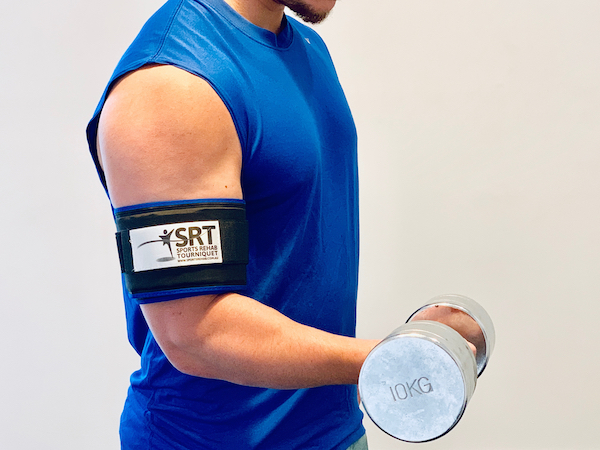BLOG
Blood flow restriction strength training



Blood Flow Restriction (BFR) strength training is a new option in rehabilitation for those needing to increase muscle size and strength, and who also need to reduce the stress on their joints. Even though BFR is new in terms of Western clinical application, there is over 40 years’ worth of research that has gone into the development of BFR training protocols. It originated in Japan in the 1960’s by Dr. Yoshiaki Sato and is known as “Kaatsu Training”, which translates to “Training Under Pressure”. Since then, it has spread to many parts of the world, becoming a treatment method for some of the most world-renowned athletes. You may have heard about it, read about it or even seen a keen gym goer almost completely cut off blood circulation to his arms with a tourniquet to get that extra pump. But what is it, and does it work?
BFR training limits the blood flow to the musculature decreasing the amount of oxygen going into the tissues. The constrictive pressure applied to the muscle also increases the amount of blood pooling in the limb, hence decreasing its ability to recover as efficiently. This may sound counter-intuitive, however BFR training has been shown to increase muscle size and muscle strength significantly when lifting lighter loads compared to just lifting light loads alone. This finding was shown with Lowery et al, 2013 when they studied the effects of performing 3 sets of 30 repetitions with 30% of their maximum lift. They found that muscle thickness increased significantly after 8 weeks.
This is great news for those who do not have the capacity to lift heavy loads such as those recovering from ACL (knee) reconstructions and other joint operations, and the older population who have sore joints. This new method of weight training is an option to still gain great strength benefits without exposure to heavy loads.
In essence, no. When BFR was compared to heavy load lifting it showed that lifting heavier loads is the optimal way to get stronger (Hughes et al, 2017).
BFR training has been shown to be effective both in strength training (with loads and weights) as well as with light cardio exercise. In both scenarios, a specialised cuff is placed around a point on the limb, and inflated to a measured pressure. The decision on exactly what pressure and dosage is used is based on the assessment of the individual.
In recent research BFR has been shown to be effective when used while walking. Those who walked for 20 minutes with the addition of BFR were shown to increase strength gains by up to 27% when compared to walking without the addition of BFR (Centner et al, 2019).
Another piece of research found BFR to have a great effect on preventing muscle wasting for those who have a limb immobilised after surgery. Positive results were shown even when BFR was utilised at a minimal pressure of 50mmHg (Hughes et al 2017). The same study also showed BFR may have some other positive health benefits aside from muscle size and strength. It may help promote protein synthesis in the older population susceptible to sarcopenia, as well as showing positive results for bone health. It was also suggested that it can keep arteries more elastic, improving arterial compliance and possibly decreasing some cardiovascular complications.
BFR sounds like the cure to everything, however there are some safety precautions and contraindications we need to consider. There are some concerns for implementing this training for those susceptible to deep vein thrombosis, cardiac disease, as well as those who are pregnant. All individuals who have recently had surgery also need to be thoroughly screened as to whether they should consider this as an option. The studies completed on BFR training showed there were occasional circumstances where numbness lingered after using BFR techniques. This was thought to be due to compression of superficial nerves and proper administering of the BFR cuff will reduce the likelihood of this.
So far, studies have shown that there were no significant increases in coagulation markers in the blood of BFR participants suggesting that BFR poses no greater risk in creating a DVT compared to regular exercise (Patterson et al, 2019).
However, as with any new technique, we need to carefully follow the progress of those who have been using BFR techniques for some time and be sure there are no long-term issues that may present further down the track.
At Malvern Physiotherapy Clinic we have the specific equipment to offer BFR training for those we think may best benefit from it. If you want to start this type of training, book in with our principal physiotherapist Mark Fotheringham and he will show you how to use this method after completing an assessment and screening test.
Note: We may also ask you to get clearance from your GP before you complete this type of session.
Published August 19, 2019